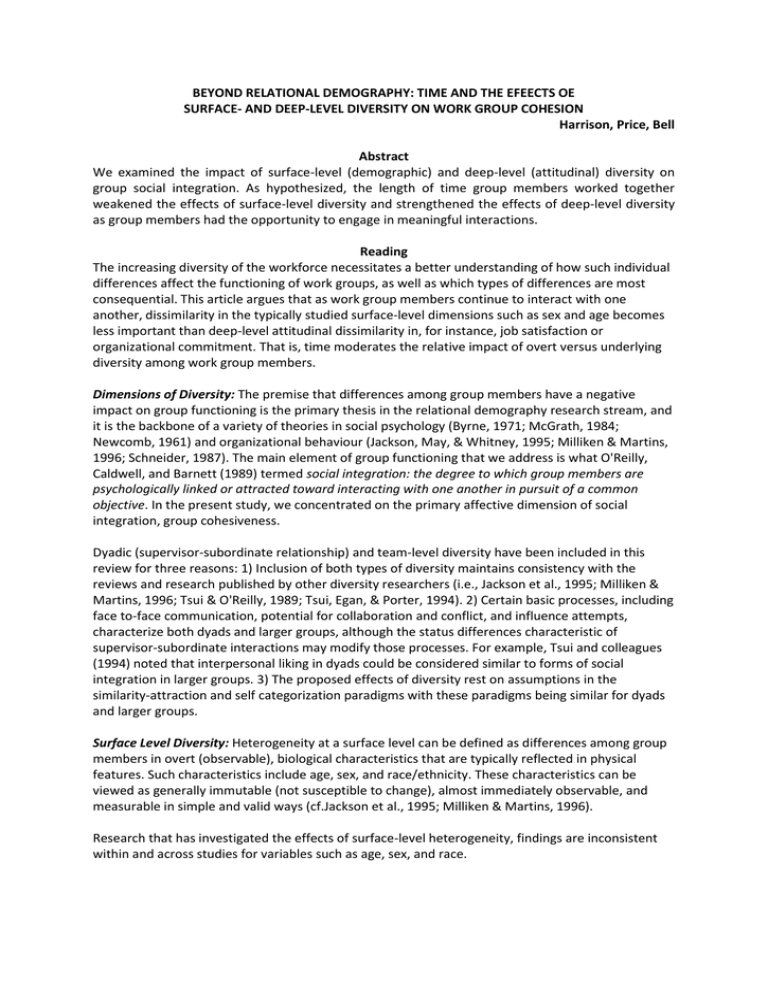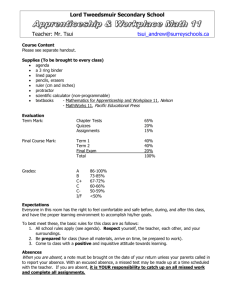BEYOND RELATIONAL DEMOGRAPHY: TIME AND THE EFEECTS
advertisement

BEYOND RELATIONAL DEMOGRAPHY: TIME AND THE EFEECTS OE SURFACE- AND DEEP-LEVEL DIVERSITY ON WORK GROUP COHESION Harrison, Price, Bell Abstract We examined the impact of surface-level (demographic) and deep-level (attitudinal) diversity on group social integration. As hypothesized, the length of time group members worked together weakened the effects of surface-level diversity and strengthened the effects of deep-level diversity as group members had the opportunity to engage in meaningful interactions. Reading The increasing diversity of the workforce necessitates a better understanding of how such individual differences affect the functioning of work groups, as well as which types of differences are most consequential. This article argues that as work group members continue to interact with one another, dissimilarity in the typically studied surface-level dimensions such as sex and age becomes less important than deep-level attitudinal dissimilarity in, for instance, job satisfaction or organizational commitment. That is, time moderates the relative impact of overt versus underlying diversity among work group members. Dimensions of Diversity: The premise that differences among group members have a negative impact on group functioning is the primary thesis in the relational demography research stream, and it is the backbone of a variety of theories in social psychology (Byrne, 1971; McGrath, 1984; Newcomb, 1961) and organizational behaviour (Jackson, May, & Whitney, 1995; Milliken & Martins, 1996; Schneider, 1987). The main element of group functioning that we address is what O'Reilly, Caldwell, and Barnett (1989) termed social integration: the degree to which group members are psychologically linked or attracted toward interacting with one another in pursuit of a common objective. In the present study, we concentrated on the primary affective dimension of social integration, group cohesiveness. Dyadic (supervisor-subordinate relationship) and team-level diversity have been included in this review for three reasons: 1) Inclusion of both types of diversity maintains consistency with the reviews and research published by other diversity researchers (i.e., Jackson et al., 1995; Milliken & Martins, 1996; Tsui & O'Reilly, 1989; Tsui, Egan, & Porter, 1994). 2) Certain basic processes, including face to-face communication, potential for collaboration and conflict, and influence attempts, characterize both dyads and larger groups, although the status differences characteristic of supervisor-subordinate interactions may modify those processes. For example, Tsui and colleagues (1994) noted that interpersonal liking in dyads could be considered similar to forms of social integration in larger groups. 3) The proposed effects of diversity rest on assumptions in the similarity-attraction and self categorization paradigms with these paradigms being similar for dyads and larger groups. Surface Level Diversity: Heterogeneity at a surface level can be defined as differences among group members in overt (observable), biological characteristics that are typically reflected in physical features. Such characteristics include age, sex, and race/ethnicity. These characteristics can be viewed as generally immutable (not susceptible to change), almost immediately observable, and measurable in simple and valid ways (cf.Jackson et al., 1995; Milliken & Martins, 1996). Research that has investigated the effects of surface-level heterogeneity, findings are inconsistent within and across studies for variables such as age, sex, and race. 1) Age: Judge and Ferris (1993) found that differences in superior-subordinate age significantly, negatively influenced supervisors' liking and subsequent ratings of subordinates' performance. Tsui and O'Reilly (1989) found that age differences were not associated with superiors' perceptions of their subordinates' performance or with superiors' liking of subordinates. Heterogeneity in age was positively associated with team turnover in the Jackson et al. (1991), Wagner, Pfeffer, and O'Reilly (1984), and Wiersema and Bird (1993) studies. Group heterogeneity in age is negatively associated with organizational attachment for some demographic subgroups (white males) but not for others (women and minorities) (Tsui et al. (1992)). O'Reilly and colleagues (1989) found that group heterogeneity with respect to age was associated with lower levels of social integration, which in turn was associated with turnover. The more distant group members were from other members in terms of age, the more likely they were to leave. 2) Sex: Research on the consequences of sex dissimilarity has also yielded conflicting results. Tsui and O'Reilly (1989) reported that subordinates whose sex differed from their supervisors' received lower performance ratings. Mobley (1982) hypothesized but did not find that supervisor-subordinate similarity in sex led to higher subordinate performance ratings. Konrad, Winter, and Gutek (1992) found that dissimilarity in sex resulted in isolation and dissatisfaction for women in some situations. 3) Race/Ethnicity: Kraiger and Ford's (1985) meta-analysis of research from 1966 to 1981 indicated that rater-ratee ethnic similarity was associated with higher performance ratings. Pulakos and coauthors' (1989) meta-analysis indicated very small and inconsistent effects of ratee-rater racial similarity across performance dimensions. Tsui and O'Reilly (1989) reported that ethnic heterogeneity was not associated with superiors' ratings of subordinates' effectiveness but was marginally related to supervisors' liking of subordinates. Deep-Level Diversity: Heterogeneity at a deep level includes differences among members' attitudes, beliefs, and values. Information about these factors is communicated through verbal and nonverbal behaviour patterns and is only learned through extended, individualized interaction and information gathering. Jackson and colleagues noted that underlying attributes like attitudes, values, knowledge and skills are “more subjected to construal and are more mutable” than other aspects. The few studies that have examined the consequences of similarity in attitudes and values in work groups have found that supervisor-subordinate attitudinal and value similarity was associated with higher subordinate performance ratings (Miles, 1964; Senger, 1971; Turban & Jones, 1988; Zalesny & Kirsch, 1989) and more accurate peer ratings (Fox, Ben-Nahum, & Yinon, 1989). Attitudinal similarity is associated with higher group cohesiveness (Terborg, Castore, & DeNinno, 1976). Turban and Jones (1988) reported that perceptions of attitudinal similarity were uniquely and positively related to subordinates' satisfaction, performance ratings, and pay ratings. Unlike the few studies on deeplevel diversity in work settings, a number of social psychological studies have reported that attitude similarity was one of the most important predictors of attraction and friendship (e.g., Antill, 1984; Byrne, 1971; McGrath, 1984; Newcomb, 1961). Similarity in attitudes can ease interpersonal interaction and increase rewards when relationships are viewed within an exchange theory framework (Thibaut & Kelley, 1959). Further, attitudinal similarity may facilitate communication; it may also reduce role conflict, because people have similar conceptualizations of their organizations and jobs, and it may reduce role ambiguity, because communication on the job increases (Tsui & O'Reilly, 1989). It can thus be inferred that as people uncover differences in attitudes, it becomes less pleasant and more difficult for them to work together. Moderating influence of Time: Research suggests that group members base an initial superficial categorization of other group members on stereotypes and subsequently modify or replace those stereotypes with deeper-level knowledge of the psychological features of the other individuals. The initial categorizations could be accompanied by perceptions of similarity or dissimilarity that are based on surface-level demographic data; these perceptions change when deep-level information is obtained (Stangor, Lynch, Duan, & Glass, 1992; Turner, 1987). Research suggests that "physical, observable, and immutable personal and background characteristics . . . play a critical role in the initial categorization process" of group members. Tsui and colleagues (1992) noted this: “conceptual foundation for almost all the research on organizational demography has been the similarityattraction paradigm (Byrne, 1971). The similarity-attraction hypothesis maintains that similarity in attitudes is a major source of attraction between individuals. A variety of physical, social, and status traits can be used as the basis for inferring similarity in attitudes, beliefs, or personality". Allport (1954) and Amir (1969) are associated with the "contact hypothesis," which states that under certain conditions, interracial or interethnic contact will result in positive group outcomes. A key supposition of this hypothesis is that as people interact to get to know one another, stereotypes are replaced by more accurate knowledge of each other as individuals, which can result in reduced prejudice and conflict and greater group cohesiveness (Amir, 1976). Hypothesis 1: Time will neutralize, or make less important, the effects of surface-level diversity on group cohesiveness, and it will enhance, or make more important, the effects of deep-level diversity. Conclusion: The existence of different levels of diversity has largely been overlooked in previous empirical studies of work groups. Examination of these different levels may help to explain the inconsistent, often conflicting results of diversity research to date. We proposed that diversity at a deep level has steadily stronger consequences for groups than demographic diversity as group members spend more time together. Although time is the variable examined in this article, the fundamental medium is information. Demographic factors are often a poor surrogate for the deeper level information people need to make accurate judgments about similarity of attitudes among group members. Time merely allows more information to be conveyed, it provides an opportunity to acquire information. The amount of information acquired is a function of the length of shared experience for group members, the breadth of group activities, the depth of task interdependence, and other factors. These exchanges allow group members to learn deeper-level information about their psychological similarity to or dissimilarity from their co-workers, where before they would have used surface-level demographic data as information proxies. Although we have argued that deep-level variables are more important over time than surface level variables in determining social integration, one could think of situations where this would not be the case. For example, Tsui and colleagues (1992) pointed out that demographic variables such as ethnicity and sex may assume more importance when associated with differences in status. High status group members (whites and men) may be more likely to withdraw when work groups are first integrated by members of perceived lower status (nonwhites and women). Limitations and Suggestions for Future Research: 1) Involved a limited set of deep level diversity variables. 2) Selection of which deep-level differences to study from a dozen of conceivably important work-related values, cultural values, terminal values, and work-related attitudes to pick from. For example, in a sports team, agreement about the importance of goal directedness, dedication, or achievement might be an overriding concern. In a university department, agreement about the relative values of teaching and research might be most significant. 3) Use of cross-sectional design 4) Common Method Variance







